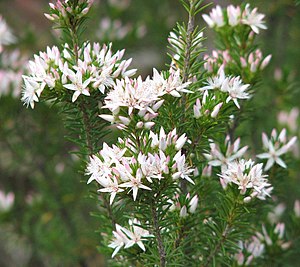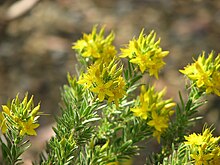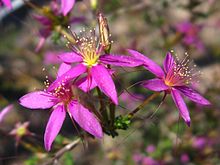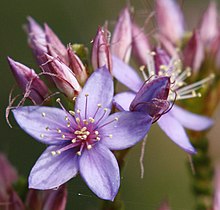Calytrix
| Calytrix | ||||||||||||
|---|---|---|---|---|---|---|---|---|---|---|---|---|

|
||||||||||||
| Systematics | ||||||||||||
|
||||||||||||
| Scientific name | ||||||||||||
| Calytrix | ||||||||||||
| Labill. |
Calytrix is a genus of plants withinthe myrtle family (Myrtaceae). All about 87 species are originally found only in Australia , where some species are called "Starflowers" or "Fringe myrtles".
description
Appearance and leaves
Calytrix species grow as evergreen shrubs that reach heights of 0.1 to 3 meters. They contain essential oils . The above-ground parts of the plant are hairy or bare. The buds can have bud scales.
The usually alternate, rarely opposite or whorled (see also epithet Calytrix verticillata ) arranged on the branches leaves are stalked or sitting. The herbaceous or leathery, simple, tiny to relatively small leaf blades are dotted with glands and have an aromatic smell. If Stipules are present, they are very small.
Inflorescences, flowers and pollination
The reduced inflorescences contain only one flower on an inflorescence stem in the leaf axils. Each flower stands over a pair of durable or quickly perishable bracts that can be fused together.
The relatively small to medium-sized, hermaphrodite flowers are radial symmetry and usually five-fold with a double flower envelope . The free flower cup (hypanthium) is tubular and usually long, it can be fused with the stylus. The five durable, free or overgrown sepals are spread out and edged at the top or usually tapered to a long point or awned. With Calytrix ecalycata (see also specific epithet) there are no sepals. The mostly five free, short nailed petals are entire, elliptical, egg-shaped or elongated. The petals usually envelop the lower area of the pistil. In Calytrix ecalycata only four petals are present. The colors of the petals are white to yellow, pink to purple. The stamens are usually straight in the bud or rarely curved a few inward. The mostly many (6 to 150) identical stamens are arranged in one or more circles and develop centripetally. The thread-like stamens are inserted on the edge of the flower cup, free from one another and not grown together with the petals. The look-alike dust bag open with longitudinal slots and extend beyond the petals. There is a discus. Two carpels are one under permanent, single-chamber ovary grown. Two anatropic ovules are usually arranged in a more or less basal placentation . Only in Calytrix praecipua are there three or four ovules and a trace of a septum. The durable, slim stylus ends in a mostly small scar.
The pollination is done by insects ( Entomophilie ) or birds ( ornithophily ).
Fruits and seeds
The dry closing fruits are solitary nut fruits . The flower cup and the then dark red to purple calyx envelop the fruit. The seeds have a membranous seed coat (testa) and containing a straight, more or less narrow inverted-egg-shaped embryo with two cotyledons short ( cotyledons ) which are planokonvex at the upper end of the thickened hypocotyl; there is no endosperm .
Chromosome number
The basic chromosome number is n = 11. Many species have diploidy and some have tetraploidy , i.e. 2n = 22 or 44.
Spread and endangerment
The genus Calytrix is widespread with around 79 species in Australia ; Species occur in all states, including Tasmania .
Swamp Starflower ( Calytrix breviseta subsp. Breviseta ) is rated as "Endangered", and Calytrix gurulmundensis is rated as "Vulnerable" .




Systematics
The genus Calytrix was established in 1806 by Jacques Julien Houtou de Labillardière in Novae Hollandiae Plantarum Specimen , Volume 2, p. 8, plate 146. Type species is Calytrix tetragona . The generic name Calytrix is derived from the Greek words kalyx for calyx and thrix for hair, this refers to the long pointed ends of the sepals of the first known species Calytrix tetragona . The last revision of the genus Calytrix was made in 1987 by Lyn A. Craven in A taxonomic revision of Calytrix Labill. (Myrtaceae) , In: Brunonia , Volume 10, pp. 1-138.
Synonyms for Calytrix Labill. are: Calycothrix Meisn. , Calythrix Labill. orth var.., Calythropsis C.A.Gardner , Lhotskya showers , Trichocalyx showers .
The genus Calytrix belongs to the tribe Chamelaucieae in the subfamily Myrtoideae within the family Myrtaceae .
There are about 87 species of Calytrix ; here with information on distribution:
- Calytrix achaeta (F.Muell.) Benth. : Northern Australia.
- Calytrix acutifolia (Lindl.) Craven : West-Southwest Western Australia.
- Calytrix alpestris (Lindl.) Court : South Australia .
- Calytrix amethystina Craven : Western Australia .
- Calytrix angulata Lindl. : Southwest Australia.
- Calytrix arborescens (F.Muell.) Benth. : Northern Territory .
- Calytrix asperula (shower) Benth. : Southwest Australia.
- Calytrix aurea Lindl. : Western Australia.
- Calytrix birdii (F.Muell.) BDJacks. : Western Australia.
- Calytrix brachychaeta (F.Muell.) Benth. : Northern Australia.
- Calytrix brevifolia (Meisn.) Benth. : Southwest Australia.
- Calytrix breviseta Lindl. : It occurs with two subspecies in southwestern Australia.
- Calytrix brownii (shower) Craven : Northern Western Australia .
- Calytrix carinata Craven : Australia.
- Calytrix chrysantha Craven : Western Australia.
- Calytrix cravenii Nge & KRThiele : West Southwest Western Australia.
- Calytrix creswellii (F.Muell.) BDJacks. : Western Australia.
- Calytrix decandra DC. : Western Australia.
- Calytrix decussata Craven : Northern Territory.
- Calytrix depressa (Turcz.) Benth. : Southwest Australia.
- Calytrix desolata S.Moore : Western Australia.
- Calytrix divergens Craven : Western Australia.
- Calytrix drummondii (Meisn.) Craven : Western Australia.
- Calytrix duplistipulata Craven : Southwest Australia.
- Calytrix ecalycata Craven : Western Australia. With three subspecies.
- Calytrix eneabbensis Craven : Western Australia.
- Calytrix erosipetala Craven : Western Australia.
- Calytrix exstipulata DC. : Northern Australia.
- Calytrix faucicola Craven : Northern Territory.
- Calytrix flavescens A. Cunn. : Southwest Australia.
- Calytrix formosa Craven : Western Australia.
- Calytrix fraseri A. Cunn. : Southwest Australia.
- Calytrix glaberrima (F.Muell.) Craven : South Australia .
- Calytrix glutinosa Lindl. : Southwest Australia.
- Calytrix gomphrenoides M.D.Barrett & Craven : Western Australia.
- Calytrix gracilis Benth. : Southwest Australia.
- Calytrix gurulmundensis Craven : It occurs only in southeastern Queensland and is known from Gurulmundi, Guluguba and Barakula northwest of Toowoomba . It is classified as "Vulnerable" = "at risk".
- Calytrix gypsophila Craven : South Australia.
- Calytrix habrantha Craven : Southwest Australia.
- Calytrix harvestiana (F.Muell.) Craven : Western Australia.
- Calytrix hirta Nge & KRThiele : Southwestern and southern South Australia.
- Calytrix hislopii Rye Rye : Western Australia.
- Calytrix inopinata Craven : Northern Territory.
- Calytrix involucrata J.M.Black : South Australia.
- Calytrix islensis Craven : Queensland.
- Calytrix leptophylla Benth. : Queensland.
- Calytrix leschenaultii (Schauer) Benth. : Western Australia.
- Calytrix longiflora (F.Muell.) Benth. : Central Australia.
- Calytrix megaphylla (F.Muell.) Benth. : Northern Territory.
- Calytrix merrelliana (F.Muell. & Tate) Craven : Southwest Australia.
- Calytrix micrairoides Craven : Northern Territory.
- Calytrix microcoma Craven : Queensland.
- Calytrix mimiana Craven : Northern Territory.
- Calytrix nematoclada Craven : Southwest Australia.
- Calytrix oldfieldii Benth. : Southwest Australia.
- Calytrix oncophylla Craven : Western Australia.
- Calytrix parvivallis Craven : Western Australia.
- Calytrix patrickiae Rye : Western Australia.
- Calytrix paucicostata Craven : Western Australia.
- Calytrix pimeleoides C.A. Gardner ex Keighery : Western Australia.
- Calytrix platycheiridia Craven : Western Australia.
- Calytrix plumulosa (F.Muell.) BDJacks. : Southwest Australia.
- Calytrix praecipua Craven : Western Australia.
- Calytrix pulchella (Turcz.) BDJacks. : Southwest Australia.
- Calytrix purpurea (F. Muell.) Craven : Western Australia.
- Calytrix retrorsifolia Nge & Keighery : The species first described in 2017 occurs in Western Australia.
- Calytrix rupestris Craven : Northern Territory.
- Calytrix sagei Rye : Western Australia.
- Calytrix sapphirina Lindl. : Southwest Australia.
- Calytrix similis Craven : Southwest Australia.
-
Calytrix simplex Lindl. : With two subspecies:
- Calytrix simplex subsp. simplex : Southwest Australia.
- Calytrix simplex subsp. suboppositifolia Craven : Southwest Australia.
- Calytrix smeatoniana (F. Muell.) Craven : South Australia.
- Calytrix strigosa A. Cunn. : Western and West-Southwest Western Australia.
- Calytrix superba C.A. Gardner & ASGeorge : Western Australia.
- Calytrix surdiviperana Craven : Northern Territory.
- Calytrix sylvana Craven : Western Australia.
- Calytrix tenuiramea (Turcz.) Benth. : Southwest Australia.
- Calytrix tetragona Labill. (Syn .: Calytrix glabra R.Br. , Calytrix scabra DC. , Calytrix ericoides A.Cunn. , Calytrix brunioides A.Cunn. , Calytrix pubescens G.Don , Calytrix sullivanii (F.Muell.) BDJacks. ): Western Australia , South Australia, Queensland.
- Calytrix truncatifolia Craven : Northwest Western Australia.
- Calytrix uncinata Craven : Western Australia.
- Calytrix variabilis Lindl. : Southwest Australia.
- Calytrix verruculosa Craven : Western Australia.
- Calytrix verticillata Craven : Northern Territory.
- Calytrix violacea (Lindl.) Craven : Southwestern Australia.
- Calytrix viscida Rye : Western Australia.
- Calytrix warburtonensis Craven : Western Australia.
- Calytrix watsonii (F.Muell. & Tate) CAGardner : Western Australia.
use
Calytrix tetragona is used as an ornamental plant because of its attractive flowers and fruits .
literature
- Lyn A. Craven: A taxonomic revision of Calytrix Labill. (Myrtaceae) , In: Brunonia , Volume 10, 1987, pp. 1-138. doi: 10.1071 / BRU9870001
Individual evidence
- ↑ a b c d e f g h i j Peter G. Wilson: Entry in the New South Wales Flora Online . last accessed on January 15, 2013
- ↑ a b c d e f g h i j k l m n o p q r s t u Entry in the Western Australian Flora , last change 2008. Accessed January 15, 2013
- ↑ a b c d e f g h i Lyn A. Craven: Entry in the Electronic Flora of South Australia genus Fact Sheet . Accessed January 15, 2013
- ↑ IPCN Chromosome Reports . Accessed January 15, 2013
- ↑ a b EPBC Act List of Threatened Flora . Accessed January 15, 2013
- ↑ Entry in Tropicos . Accessed January 15, 2013
- ↑ a b Entry in Australian Plant Name Index = APNI. Accessed January 15, 2013
- ^ A b Calytrix in Germplasm Resources Information Network (GRIN), USDA , ARS , National Genetic Resources Program. National Germplasm Resources Laboratory, Beltsville, Maryland. Accessed January 15, 2013
- ↑ a b c d e f g h i j k l m n o p q r s t u v w x y z aa ab ac ad ae af ag ah ai aj ak al am an ao ap aq ar as at au av aw ax ay az ba bb bc bd be bf bg bh bi bj bk bl bm bn bo bp bq br bs bt bu bv bw bx by bz ca cb cc cd ce cf cg ch ci cj ck Rafaël Govaerts (Ed.): Calytrix. In: World Checklist of Selected Plant Families (WCSP) - The Board of Trustees of the Royal Botanic Gardens, Kew . Retrieved April 27, 2020.
- ↑ Gordon Cheers (Ed.): Botanica. The ABC of plants. 10,000 species in text and images . Könemann Verlagsgesellschaft, 2003, ISBN 3-8331-1600-5 (therein page 175).
Web links
- Rodger Elliot: Shrubby Myrtles at Australian Plants Online . last accessed on January 15, 2013





